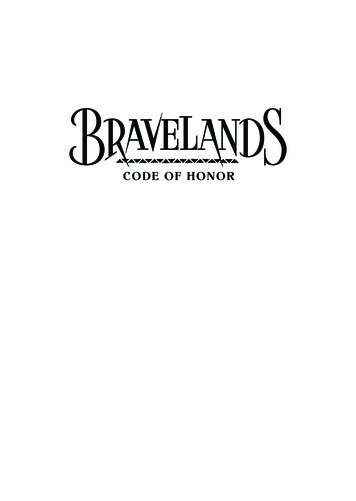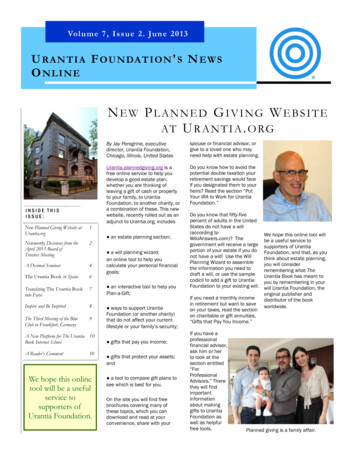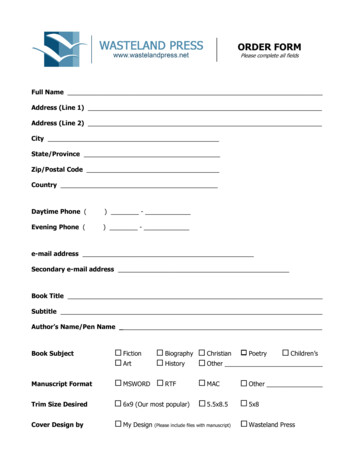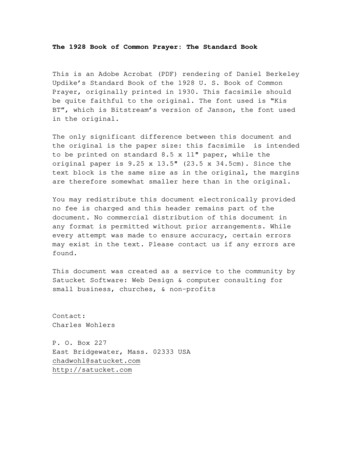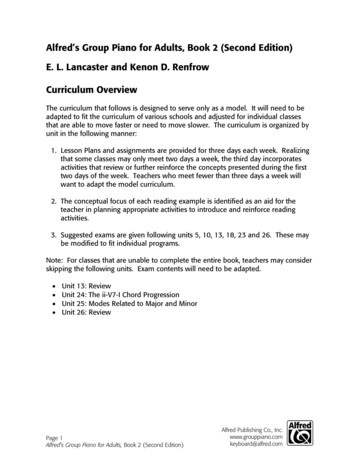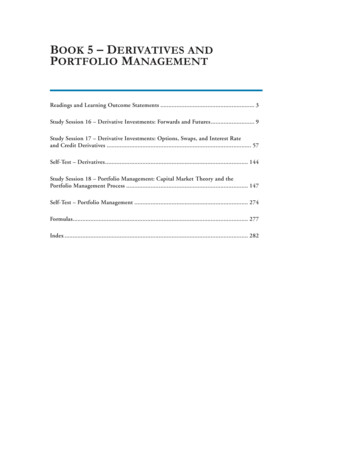
Transcription
Book 5 – Derivatives andPortfolio ManagementReadings and Learning Outcome Statements. 3Study Session 16 – Derivative Investments: Forwards and Futures. 9Study Session 17 – Derivative Investments: Options, Swaps, and Interest Rateand Credit Derivatives. 57Self-Test – Derivatives. 144Study Session 18 – Portfolio Management: Capital Market Theory and thePortfolio Management Process. 147Self-Test – Portfolio Management. 274Formulas. 277Index. 282Level 2 Book 5.indb 19/17/2010 3:30:30 PM
SchweserNotes 2011 CFA Level 2 Book 5: Derivatives and Portfolio Management 2010 Kaplan, Inc. All rights reserved.Published in 2010 by Kaplan Schweser.Printed in the United States of America.ISBN: 978-1-4277-2732-9 / 1-4277-2732-5PPN: 3200-0072If this book does not have the hologram with the Kaplan Schweser logo on the back cover, it was distributed without permission of KaplanSchweser, a Division of Kaplan, Inc., and is in direct violation of global copyright laws. Your assistance in pursuing potential violators of thislaw is greatly appreciated.Required CFA Institute disclaimer: “CFA and Chartered Financial Analyst are trademarks owned by CFA Institute. CFA Institute(formerly the Association for Investment Management and Research) does not endorse, promote, review, or warrant the accuracy of theproducts or services offered by Kaplan Schweser.”Certain materials contained within this text are the copyrighted property of CFA Institute. The following is the copyright disclosure forthese materials: “Copyright, 2011, CFA Institute. Reproduced and republished from 2011 Learning Outcome Statements, Level 1, 2,and 3 questions from CFA Program Materials, CFA Institute Standards of Professional Conduct, and CFA Institute’s Global InvestmentPerformance Standards with permission from CFA Institute. All Rights Reserved.”These materials may not be copied without written permission from the author. The unauthorized duplication of these notes is a violation ofglobal copyright laws and the CFA Institute Code of Ethics. Your assistance in pursuing potential violators of this law is greatly appreciated.Disclaimer: The Schweser Notes should be used in conjunction with the original readings as set forth by CFA Institute in their 2011 CFALevel 2 Study Guide. The information contained in these Notes covers topics contained in the readings referenced by CFA Institute and isbelieved to be accurate. However, their accuracy cannot be guaranteed nor is any warranty conveyed as to your ultimate exam success. Theauthors of the referenced readings have not endorsed or sponsored these Notes.Level 2 Book 5.indb 29/17/2010 3:30:30 PM
Readings andLearning Outcome StatementsReadingsThe following material is a review of the Derivatives and Portfolio Management principlesdesigned to address the learning outcome statements set forth by CFA Institute.Study Session 16Reading AssignmentsDerivatives and Portfolio Management, CFA Program Curriculum, Volume 6, Level 2(CFA Institute, 2011)60. Forward Markets and Contracts61. Futures Markets and Contractspage 9page 36Study Session 17Reading AssignmentsDerivatives and Portfolio Management, CFA Program Curriculum, Volume 6, Level 2(CFA Institute, 2011)62. Option Markets and Contracts63. Swap Markets and Contracts64. Interest Rate Derivative Instruments65. Using Credit Derivatives to Enhance Return and Manage Riskpage 57page 98page 126page 134Study Session 18Reading AssignmentsDerivatives and Portfolio Management, CFA Program Curriculum, Volume 6,Level 2 (CFA Institute, 2011)66. Portfolio Concepts67. A Note on Harry M. Markowitz’s “Market Efficiency: A TheoreticalDistinction and So What?”68. International Asset Pricing69. The Theory of Active Portfolio Management70. The Portfolio Management Process and the Investment PolicyStatement 2010 Kaplan, Inc.Level 2 Book 5.indb 3page 147page 211page 216page 246page 260Page 39/17/2010 3:30:30 PM
Book 5 – Derivatives and Portfolio ManagementReadings and Learning Outcome StatementsLearning Outcome Statements (LOS)The CFA Institute Learning Outcome Statements are listed below. These are repeated in eachtopic review; however, the order may have been changed in order to get a better fit with theflow of the review.Study Session 16The topical coverage corresponds with the following CFA Institute assigned reading:60. Forward Markets and ContractsThe candidate should be able to:a. explain how the value of a forward contract is determined at initiation, duringthe life of the contract, and at expiration. (page 14)b. calculate and interpret the price and the value of an equity forward contract,assuming dividends are paid either discretely or continuously. (page 16)c. calculate and interpret the price and the value of 1) a forward contract on afixed-income security, 2) a forward rate agreement (FRA), and 3) a forwardcontract on a currency. (page 20)d. evaluate credit risk in a forward contract, and explain how market value is ameasure of the credit risk to a party in a forward contract. (page 28)The topical coverage corresponds with the following CFA Institute assigned reading:61. Futures Markets and ContractsThe candidate should be able to:a. explain why the futures price must converge to the spot price at expiration.(page 36)b. determine the value of a futures contract. (page 37)c. explain how forward and futures prices differ. (page 38)d. describe the monetary and nonmonetary benefits and costs associated withholding the underlying asset, and explain how they affect the futures price.(page 42)e. describe backwardation and contango. (page 43)f. discuss whether futures prices equal expected spot prices. (page 43)g. describe the difficulties in pricing Eurodollar futures and creating a purearbitrage opportunity. (page 46)h. calculate and interpret the price of Treasury bond futures, stock index futures,and currency futures. (page 46)Study Session 17The topical coverage corresponds with the following CFA Institute assigned reading:62. Option Markets and ContractsThe candidate should be able to:a. calculate and interpret the prices of a synthetic call option, synthetic put option,synthetic bond, and synthetic underlying stock, and infer why an investor wouldwant to create such instruments. (page 58)b. calculate and interpret prices of interest rate options and options on assets usingone- and two-period binomial models. (page 61)Page 4Level 2 Book 5.indb 4 2010 Kaplan, Inc.9/17/2010 3:30:30 PM
Book 5 – Derivatives and Portfolio ManagementReadings and Learning Outcome Statementsc. explain the assumptions underlying the Black-Scholes-Merton model and theirlimitations. (page 74)d. explain how an option price, as represented by the Black-Scholes-Merton model,is affected by each of the input values (the option Greeks). (page 76)e. explain the delta of an option, and demonstrate how it is used in dynamichedging. (page 79)f. explain the gamma effect on an option’s price and delta and how gamma canaffect a delta hedge. (page 84)g. discuss the effect of the underlying asset’s cash flows on the price of an option.(page 84)h. demonstrate the methods for estimating the future volatility of the underlyingasset (i.e., the historical volatility and the implied volatility methods). (page 85)i. illustrate how put-call parity for options on forwards (or futures) is established.(page 86)j. compare and contrast American options on forwards and futures with Europeanoptions on forwards and futures, and identify the appropriate pricing model forEuropean options. (page 88)The topical coverage corresponds with the following CFA Institute assigned reading:63. Swap Markets and ContractsThe candidate should be able to:a. distinguish between the pricing and valuation of swaps. (page 98)b. explain the equivalence of 1) interest rate swaps to a series of off-market forwardrate agreements (FRAs) and 2) a plain vanilla swap to a combination of aninterest rate call and an interest rate put. (page 99)c. calculate and interpret the fixed rate on a plain vanilla interest rate swap and themarket value of the swap during its life. (page 100)d. calculate and interpret the fixed rate, if applicable, and the foreign notionalprincipal for a given domestic notional principal on a currency swap, anddetermine the market values of each of the different types of currency swapsduring their lives. (page 107)e. calculate and interpret the fixed rate, if applicable, on an equity swap and themarket values of the different types of equity swaps during their lives. (page 111)f. explain and interpret the characteristics and uses of swaptions, including thedifference between payer and receiver swaptions. (page 113)g. identify and calculate the possible payoffs and cash flows of an interest rateswaption. (page 113)h. calculate and interpret the value of an interest rate swaption on the expirationday. (page 114)i. evaluate swap credit risk for each party and during the life of the swap,distinguish between current credit risk and potential credit risk, and illustratehow swap credit risk is reduced by both netting and marking to market.(page 115)j. define swap spread and relate it to credit risk. (page 116)The topical coverage corresponds with the following CFA Institute assigned reading:64. Interest Rate Derivative InstrumentsThe candidate should be able to:a. demonstrate how both a cap and a floor are packages of options on interest ratesand options on fixed-income instruments. (page 126)b. compute the payoff for a cap and a floor, and explain how a collar is created.(page 128) 2010 Kaplan, Inc.Level 2 Book 5.indb 5Page 59/17/2010 3:30:30 PM
Book 5 – Derivatives and Portfolio ManagementReadings and Learning Outcome StatementsThe topical coverage corresponds with the following CFA Institute assigned reading:65. Using Credit Derivatives to Enhance Return and Manage RiskThe candidate should be able to:a. describe the characteristics of a credit default swap, and compare and contrast acredit default swap with a corporate bond. (page 134)b. explain the advantages of using credit derivatives over other credit instruments.(page 136)c. explain the use of credit derivatives by the various market participants.(page 136)d. discuss credit derivatives trading strategies and how they are used by hedge fundsand other managers. (page 137)Study Session 18The topical coverage corresponds with the following CFA Institute assigned reading:66. Portfolio ConceptsThe candidate should be able to:a. discuss mean-variance analysis and its assumptions, and calculate the expectedreturn and the standard deviation of return for a portfolio of two or three assets.(page 147)b. explain the minimum-variance and efficient frontiers, and discuss the steps tosolve for the minimum-variance frontier. (page 152)c. discuss diversification benefits, and explain how the correlation in a twoasset portfolio and the number of assets in a multi-asset portfolio affect thediversification benefits. (page 156)d. calculate the variance of an equally weighted portfolio of n stocks, explain thecapital allocation and the capital market lines (CAL and CML) and the relationbetween them, and calculate the values of one of the variables given the values ofthe remaining variables. (page 159)e. explain the capital asset pricing model (CAPM), including its underlyingassumptions and the resulting conclusions. (page 169)f. discuss the security market line (SML), the beta coefficient, the market riskpremium, and the Sharpe ratio, and calculate the value of one of these variablesgiven the values of the remaining variables. (page 170)g. explain the market model, and state and interpret the market model’s predictionswith respect to asset returns, variances, and covariances. (page 177)h. calculate an adjusted beta, and discuss the use of adjusted and historical betas aspredictors of future betas. (page 179)i. discuss reasons for and problems related to instability in the minimum-variancefrontier. (page 181)j. discuss and compare macroeconomic factor models, fundamental factor models,and statistical factor models. (page 182)k. calculate the expected return on a portfolio of two stocks, given the estimatedmacroeconomic factor model for each stock. (page 186)l. discuss the arbitrage pricing theory (APT), including its underlying assumptionsand its relation to the multifactor models, calculate the expected return onan asset given an asset’s factor sensitivities and the factor risk premiums, anddetermine whether an arbitrage opportunity exists, including how to exploit theopportunity. (page 187)Page 6Level 2 Book 5.indb 6 2010 Kaplan, Inc.9/17/2010 3:30:30 PM
Book 5 – Derivatives and Portfolio ManagementReadings and Learning Outcome Statementsm. explain the sources of active risk, define and interpret tracking error, trackingrisk, and the information ratio, and explain factor portfolio and trackingportfolio. (page 190)n. compare and contrast the conclusions and the underlying assumptions of theCAPM and the APT models, and explain why an investor can possibly earn asubstantial premium for exposure to dimensions of risk unrelated to marketmovements. (page 194)The topical coverage corresponds with the following CFA Institute assigned reading:67. A Note on Harry M. Markowitz’s “Market Efficiency: A Theoretical Distinctionand So What?”The candidate should be able to:a. discuss the efficiency of the market portfolio in the CAPM and the relationbetween the expected return and beta of an asset when restrictions on borrowingat the risk-free rate and on short selling exist. (page 211)b. discuss the practical consequences that follow when restrictions on borrowing atthe risk-free rate and on short selling exist. (page 212)The topical coverage corresponds with the following CFA Institute assigned reading:68. International Asset PricingThe candidate should be able to:a. explain international market integration and segmentation and the impedimentsto international capital mobility. (page 216)b. discuss the factors that favor international market integration. (page 217)c. discuss the assumptions of the domestic capital asset pricing model (CAPM).(page 218)d. justify the extension of the domestic CAPM to an international context (theextended CAPM), and discuss the assumptions needed to make the extension.(page 218)e. determine whether the real exchange rate has changed in a period. (page 219)f. calculate the expected 1) exchange rate and 2) domestic-currency holding periodreturn on a foreign bond (security). (page 221)g. calculate the end-of-period real exchange rate and the domestic-currency ex-postreturn on a foreign bond (security). (page 221)h. calculate a foreign currency risk premium, and explain a foreign currency riskpremium in terms of interest rate differentials and forward rates. (page 222)i. state the risk pricing relation and the formula for the international capital assetpricing model (ICAPM), and calculate the expected return on a stock using themodel. (page 224)j. explain the effect of market segmentation on the ICAPM. (page 227)k. define currency exposure, and explain exposures in terms of correlations.(page 228)l. discuss the likely exchange rate exposure of a company based on a descriptionof the company’s activities, and explain the impact of both real and nominalexchange rate changes on the valuation of the company. (page 230)m. discuss the currency exposures of national economies, equity markets, and bondmarkets. (page 231)n. contrast the traditional trade approach (j-curve) and the money demandapproach to modeling the relation between real exchange rate changes anddomestic economic activity. (page 231) 2010 Kaplan, Inc.Level 2 Book 5.indb 7Page 79/17/2010 3:30:30 PM
Book 5 – Derivatives and Portfolio ManagementReadings and Learning Outcome StatementsThe topical coverage corresponds with the following CFA Institute assigned reading:69. The Theory of Active Portfolio ManagementThe candidate should be able to:a. justify active portfolio management when security markets are nearly efficient.(page 246)b. discuss the steps and the approach of the Treynor-Black model for securityselection. (page 247)c. describe how an analyst’s accuracy in forecasting alphas can be measuredand how estimates of forecasting can be incorporated into the Treynor-Blackapproach. (page 253)The topical coverage corresponds with the following CFA Institute assigned reading:70. The Portfolio Management Process and the Investment Policy StatementThe candidate should be able to:a. explain the importance of the portfolio perspective. (page 261)b. describe the steps of the portfolio management process and the components ofthose steps. (page 261)c. define investment objectives and constraints, and explain and distinguish amongthe types of investment objectives and constraints. (page 262)d. discuss the role of the investment policy statement in the portfolio managementprocess, and explain the elements of an investment policy statement. (page 265)e. explain how capital market expectations and the investment policy statementhelp influence the strategic asset allocation decision, and discuss how aninvestor’s investment time horizon may influence the investor’s strategic assetallocation. (page 266)f. contrast the types of investment time horizons, determine the time horizon fora particular investor, and evaluate the effects of this time horizon on portfoliochoice. (page 266)g. justify ethical conduct as a requirement for managing investment portfolios.(page 267)Page 8Level 2 Book 5.indb 8 2010 Kaplan, Inc.9/17/2010 3:30:30 PM
The following is a review of the Derivative Investments principles designed to address the learningoutcome statements set forth by CFA Institute . This topic is also covered in:Forward Markets andContractsStudy Session 16Exam FocusThis topic review covers the calculation of price and value for forward contracts, specificallyequity forward contracts, T-bond forward contracts, currency forwards, and forward(interest) rate agreements. You need to have a good understanding of the no-arbitrageprinciple that underlies these calculations because it is used in the topic reviews of futuresand swaps pricing as well. There are several important price and value formulas in thisreview. A clear understanding of the sources and timing of forward contract settlementpayments will enable you to be successful on this portion of the exam without dependingon pure memorization of these complex formulas. In the past, candidates have been testedon their understanding of the relationship of the payments at settlement to interest ratechanges, asset price changes, and index level changes. The pricing conventions for theunderlying assets have been tested separately. The basic contract mechanics are certainly“fair game,” so don’t overlook the easy stuff by spending too much time trying to memorizethe formulas.Warm-Up: Forward ContractsThe party to the forward contract that agrees to buy the financial or physical asset hasa long forward position and is called the long. The party to the forward contract thatagrees to sell/deliver the asset has a short forward position and is called the short.We will illustrate the basic forward contract mechanics through an example based onthe purchase and sale of a Treasury bill. Note that while forward contracts on T-bills areusually quoted in terms of a discount percentage from face value, we use dollar priceshere to make the example easy to follow.Consider a contract under which Party A agrees to buy a 1,000 face value 90-dayTreasury bill from Party B 30 days from now at a price of 990. Party A is the long andParty B is the short. Both parties have removed uncertainty about the price they willpay or receive for the T-bill at the future date. If 30 days from now T-bills are trading at 992, the short must deliver the T-bill to the long in exchange for a 990 payment. IfT-bills are trading at 988 on the future date, the long must purchase the T-bill from theshort for 990, the contract price.Each party to a forward contract is exposed to default risk, the probability that the otherparty (the counterparty) will not perform as promised. Typically, no money changeshands at the inception of the contract, unlike futures contracts in which each party postsan initial deposit called the margin as a guarantee of performance. 2010 Kaplan, Inc.Level 2 Book 5.indb 9Page 99/17/2010 3:30:30 PM
Study Session 16Study Session 16Cross-Reference to CFA Institute Assigned Reading #60 – Forward Markets and ContractsAt any point in time, including the settlement date, the party to the forward contractwith the negative value will owe money to the other side. The other side of the contractwill have a positive value of equal amount. Following this example, if the T-bill price is 992 at the (future) settlement date, and the short does not deliver the T-bill for 990 aspromised, the short has defaulted.Professor’s Note: For the basics of forward contracts, please see the onlineSchweser Library.Warm-Up: Forward Contract Price DeterminationThe No-Arbitrage PrincipleThe price of a forward contract is not the price to purchase the contract because theparties to a forward contract typically pay nothing to enter into the contract at itsinception. Here, price refers to the contract price of the underlying asset under the termsof the forward contract. This price may be a U.S. dollar or euro price but it is oftenexpressed as an interest rate or currency exchange rate. For T-bills, the price will beexpressed as an annualized percentage discount from face value; for coupon bonds, itwill usually be expressed as a yield to maturity; for the implicit loan in a forward rateagreement (FRA), it will be expressed as annualized London Interbank Offered Rate(LIBOR); and for a currency forward, it is expressed as an exchange rate between thetwo currencies involved. However it is expressed, this rate, yield, discount, or dollaramount is the forward price in the contract.The price that we wish to determine is the forward price that makes the values ofboth the long and the short positions zero at contract initiation. We will use the noarbitrage principle: there should not be a riskless profit to be gained by a combination ofa forward contract position with positions in other assets. This principle assumes that(1) transactions costs are zero, (2) there are no restrictions on short sales or on the useof short sale proceeds, and (3) both borrowing and lending can be done in unlimitedamounts at the risk-free rate of interest. This concept is so important, we’ll express it ina formula:forward price price that would not permit profitable riskless arbitrage in frictionlessmarketsA Simple Version of the Cost-of-Carry ModelIn order to explain the no-arbitrage condition as it applies to the determination offorward prices, we will first consider a forward contract on an asset that costs nothingto store and makes no payments to its owner over the life of the forward contract. Azero-coupon (pure discount) bond meets these criteria. Unlike gold or wheat, it hasno storage costs; unlike stocks, there are no dividend payments to consider; and unlikecoupon bonds, it makes no periodic interest payments.Page 10Level 2 Book 5.indb 10 2010 Kaplan, Inc.9/17/2010 3:30:30 PM
Study Session 16Cross-Reference to CFA Institute Assigned Reading #60 – Forward Markets and ContractsThe general form for the calculation of the forward contract price can be stated asfollows:tFP S0 (1 r f )orS0 FP(1 r f )twhere:FP forward priceS0 spot prrice at inception of the contract (t 0)r f annual risk-free ratet forward contract term in yearsExample: Calculating the no-arbitrage forward priceConsider a 3-month forward contract on a zero-coupon bond with a face value of 1,000 that is currently quoted at 500, and assume a risk-free annual interest rate of6%. Determine the price of the forward contract under the no-arbitrage principle.Answer:t 3 12 0.25tFP S0 (1 r f ) 500 1.060.25 507.34Now, let’s explore in more detail why 507.34 is the no-arbitrage price of the forwardcontract.Cash and Carry Arbitrage When the Forward Contract is OverpricedSuppose the forward contract is actually trading at 510 rather than the no-arbitrageprice of 507.34. A short position in the forward contract requires the delivery of thisbond three months from now. The arbitrage that we examine in this case amountsto borrowing 500 at the risk-free rate of 6%, buying the bond for 500, andsimultaneously taking the short position in the forward contract on the zero-couponbond so that we are obligated to deliver the bond at the expiration of the contract forthe forward price and receive 510.At the settlement date, we can satisfy our obligation under the terms of the forwardcontract by delivering the zero-coupon bond for a payment of 510, regardless of itsmarket value at that time. We will use the 510 payment we receive at settlement from 2010 Kaplan, Inc.Level 2 Book 5.indb 11Page 119/17/2010 3:30:30 PM
Study Session 16Study Session 16Cross-Reference to CFA Institute Assigned Reading #60 – Forward Markets and Contractsthe forward contract (the forward contract price) to repay the 500 loan. The totalamount to repay the loan, since the term of the loan is three months, is:0.25loan repayment 500 (1.06) 507.34The payment of 510 we receive when we deliver the bond at the forward price isgreater than our loan payoff of 507.34, and we will have earned an arbitrage profit of 510 – 507.34 2.66. Notice that this is equal to the difference between the actualforward price and the no-arbitrage forward price. The transactions are illustrated inFigure 1.Figure 1: Cash and Carry Arbitrage When Forward is OverpricedTodayThree Months From TodaySpot price of bond 500Forward price 510TransactionShort forwardCash flow 0Buy bond– 500Borrow at 6% 500Total cash flow 0TransactionCash flowSettle short positionby delivering bond 510.00Repay loanTotal cash flow arbitrage profit– 507.34 2.66Professor’s Note: Here’s a hint to help you remember which transactions toundertake for cash and carry arbitrage. You always want to buy underpricedassets and sell overpriced assets, so if the futures contract is overpriced, you wantto take a short position that gives you the obligation to sell at a fixed price.Because you go short in the forward market, you take the opposite position in thespot market and buy the asset. You need money to buy the asset, so you have toborrow. Therefore, the first step in cash and carry arbitrage at its most basic is:forward overpriced short (sell) forward long (buy) spot asset borrowmoneyReverse Cash and Carry Arbitrage When the Forward Contract is UnderpricedSuppose the forward contract is actually trading at 502 instead of the no-arbitrageprice of 507.34. We reverse the arbitrage trades from the previous case and generatean arbitrage profit as follows. We sell the bond short today for 500 and simultaneouslytake the long position in the forward contract, which obligates us to purchase the bondin 90 days at the forward price of 502. We invest the 500 proceeds from the short saleat the 6% annual rate for three months.Page 12Level 2 Book 5.indb 12 2010 Kaplan, Inc.9/17/2010 3:30:31 PM
Study Session 16Cross-Reference to CFA Institute Assigned Reading #60 – Forward Markets and ContractsIn this case, at the settlement date, we receive the investment proceeds of 507.34,accept delivery of the bond in return for a payment of 502, and close out our shortposition by delivering the bond we just purchased at the forward price.The payment of 502 we make as the long position in the contract is less than investmentproceeds of 507.34, and we have earned an arbitrage profit of 507.34 – 502 5.34.The transactions are illustrated in Figure 2.Figure 2: Reverse Cash and Carry Arbitrage When Forward is UnderpricedTodayThree Months From TodaySpot price of bond 500Forward price 502TransactionLong forwardShort sell bondInvest short-saleproceeds at 6%Total cash flowCash flow 0 500– 500 0TransactionCash flowSettle long positionby buying bond– 502.00Deliver bond to closeshort positionReceive investmentproceedsTotal cash flow arbitrage profit 0.00 507.34 5.34Professor’s Note: In this case, because the forward contract is underpriced, thetrades are reversed from cash and carry arbitrage:forward underpriced long (buy) forward short sell spot asset investmoneyWe can now determine that the no-arbitrage forward price that yields a zero value forboth the long and short positions in the forward contract at inception is the no-arbitrageprice of 507.34.Professor’s Note: This long explanation has answered the question, “What is theforward price that allows no arbitrage?” You’ll have to trust me, but a very clearunderstanding here will make what follows easier and will serve you well as weprogress to futures, options, and swaps. 2010 Kaplan, Inc.Level 2 Book 5.indb 13Page 139/17/2010 3:30:31 PM
Study Session 16Study Session 16Cross-Reference to CFA Institute Assigned Reading #60 – Forward Markets and ContractsLOS 60.a: Explain how the value of a forward contract is determined atinitiation, during the life of the contract, and at expiration.If we denote the value of the long position in a forward contract at time t as Vt, thevalue of the long position at cont
Level 2 Study guide. the information contained in these Notes covers topics contained in the readings referenced by cFA institute and is believed to be accurate. however, their accuracy cannot be guaranteed nor is an


